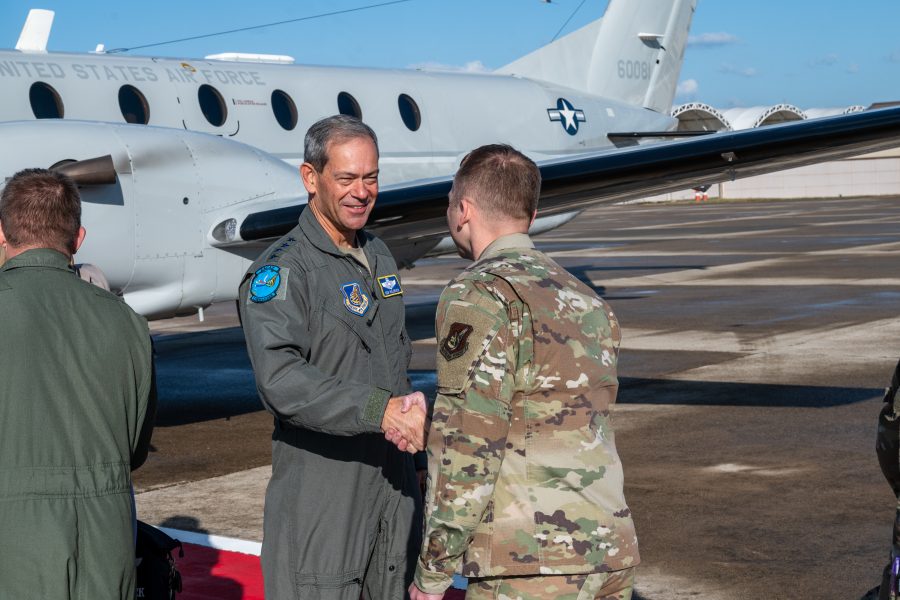Pacific Air Forces leaders conducted readiness inspections and spoke about quality of life concerns with Airmen during a sweep of the U.S. Air Force’s two bases in South Korea last week.
PACAF commander Gen. Kenneth S. Wilsbach and PACAF command chief Chief Master Sgt. David Wolfe stopped by Osan and Kunsan air bases on Oct. 19 and 20, emphasizing the enduring U.S. commitment to the region.
“We are here in Korea to stay,” Wilsbach said while visiting the 51st Fighter Wing at Osan base, according to a release.
Both South Korean bases are strategically located near North Korea, China, and Russia, making their responsiveness essential for the broader Indo-Pacific region’s stability.
“While the Wolf Pack’s main objective is to defend this country [Republic of Korea], I want to also emphasize that Kunsan’s readiness has a larger impact on the actions of these nations in the broader region,” said Wilsbach, while meeting with Airmen at the 8th Fighter Wing.
The command team discussed PACAF priorities, assessed readiness, and reviewed long-term infrastructure strategies during their visit.
Wilsbach and Wolfe’s tour of Korean bases came in conjunction with a visit to the Seoul Air and Defense Expo, which showcased a wide range of USAF aircraft including the B-52, F-22s, and F-16s.
Earlier this week, the U.S., ROK, and Japan conducted their first-ever trilateral aerial exercise on Oct. 22. A U.S. B-52H Stratofortress was escorted by fighter aircraft from all three nations.
North Korea has condemned the presence of B-52s in the peninsula through its state-controlled KCNA media.
While Wilsbach emphasized the importance of the Air Force’s presence in Korea, acting undersecretary of defense for policy Mara Karlin also highlighted the significance of the U.S.’s close collaboration with South Korea and Japan to address the growing threat from North Korea effectively.
“We’ve got these persistent threats that exist and that are probably going to worsen,” Karlin said at a Brookings event on Oct. 24. “So we’ve got to really understand how to monitor and respond to those threats, and to do so in a way that really involves working closely with allies and partners.”
Pyongyang’s most recent provocation was the launch of two short-range ballistic missiles ahead of a bilateral summit between Kim Jong Un and Russia’s Vladimir Putin on Sept. 13, according to South Korean military officials.
In April, Washington and Seoul established the Nuclear Consultative Group through the “Washington Declaration” to reinforce a unified approach to regional security while promoting dialogue and diplomacy with North Korea for denuclearization.
National Security Advisor Jake Sullivan highlighted the Biden administration’s commitment to bolster extended deterrence in response to Pyongyang’s threats.
“In the face of North Korea’s dangerous and illicit nuclear and missile programs, we are working to ensure that the United States’ extended deterrence is stronger than ever so that the region remains peaceful and stable,” Sulivan wrote in an article for Foreign Affairs, published Oct. 24.
“That is why we concluded the Washington Declaration with South Korea and why we’re advancing extended trilateral deterrence discussions with Japan, as well.”
Recent reports have suggested Hamas utilized North Korean-made munitions in their attack. As a result, observers have expressed concerns regarding the potential for Pyongyang’s engagement with militant groups in the Middle East, and the possibility of North Korea emulating Hamas’ attacks within the peninsula.
Bruce Bennett, international/defense researcher at the RAND Corporation, suggested in a recent commentary that while it is unlikely that leader Kim Jong Un would resort to a full-scale attack similar to Hamas, he does share the goal of discouraging U.S. military involvement in the region.
